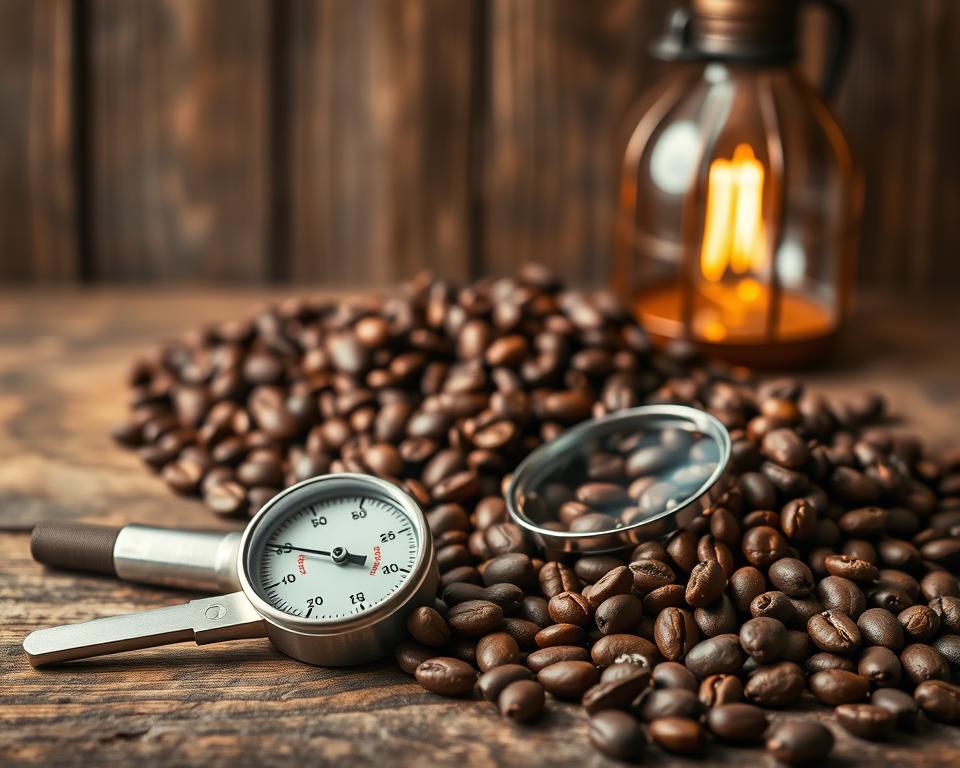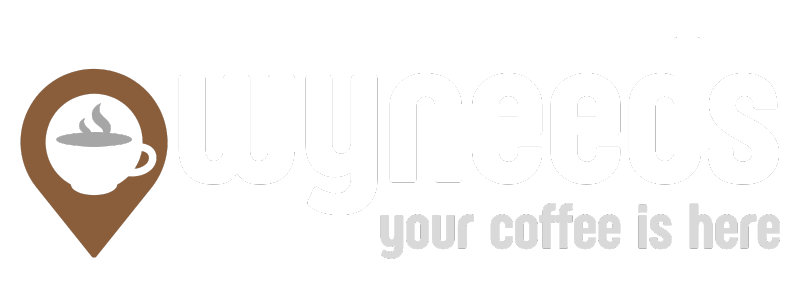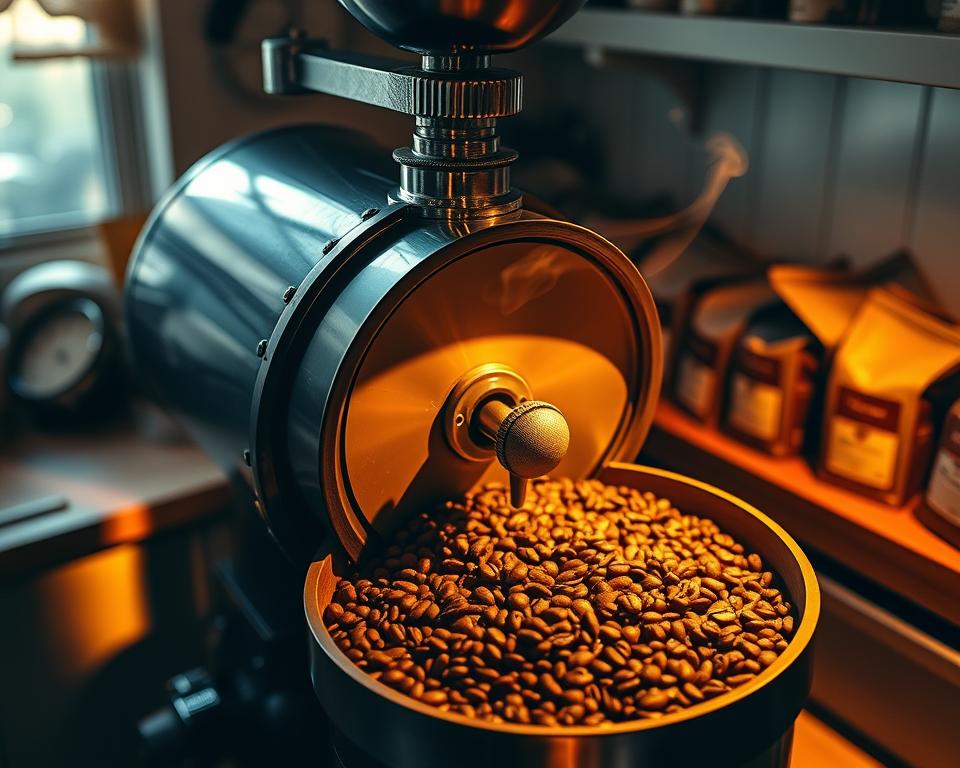Coffee roasting transforms green beans into the aromatic brew enjoyed by over 1 billion people daily. For Americans sipping 400 million cups a day, mastering a roast profile unlocks the potential of every bean. This guide helps you craft flavors tailored to your taste, from light roasts at 356–401°F to dark roasts reaching up to 482°F. Every temperature shift, from the first crack at 385°F to the second crack at 435°F, shapes the final cup’s aroma and bitterness.
A consistent roast profile ensures your brew stands out. With over 800 compounds changing during roasting, small adjustments can highlight fruity notes in Arabica or bold Robusta flavors. Whether using a home roaster for 100g batches or experimenting with Sweet Maria’s beans, this guide breaks down science into actionable steps. From drying phases to finalizing flavor, you’ll learn how time and heat create your perfect cup.
Key Takeaways
- Roast profiles control flavor by balancing time, temperature, and bean type.
- Light to dark roasts range between 356°F and 482°F, impacting bitterness and aroma.
- Tracking variables like charge temperature and first crack improves consistency.
- Arabica beans dominate global production, offering nuanced flavors compared to Robusta.
- Organized methods and supplier relationships boost roasting success.
What is a Roast Profile?
A roast profile is akin to a recipe for coffee beans, detailing how heat and time transform raw beans into your ideal cup. It’s a roast curve, a visual representation of temperature changes during the roast process. This curve is crucial for home roasters, allowing them to replicate favorite flavors and avoid common pitfalls.
“Without a roast profile, every batch is a gamble,” says James Hoffmann, a renowned coffee expert. “A good profile turns consistency into a science.”
Definition and Importance
Every roast profile outlines essential steps: drying beans, developing flavors through the Maillard reaction, and cracking stages. These steps are vital to ensure beans reach optimal roast curve points. For instance, light roasts, such as cinnamon roast, are stopped early to preserve the original flavors. On the other hand, dark roasts, like French roast, are roasted longer to emphasize bold, smoky notes.
Components of a Roast Profile
Professionals meticulously track several key parameters in every roast profile:
| Parameter | Role |
|---|---|
| Charge Temperature | Starting heat for beans |
| Development Time | Time between first crack and end |
| Rate of Rise (ROR) | Measures heat absorption speed |
| End Temperature | Final heat level (e.g., 227°C for KL Classic profiles) |
By adjusting these parameters, you can tailor roasts to different bean types. For example, dense beans require slower roasts to prevent burning. It’s essential to document each adjustment. This practice builds a personal roast profile library!
Understanding Coffee Roasting Levels
Coffee beans undergo a transformation through three main roast levels. Each level shapes the flavor and color of the beans. These levels determine how the origin flavors evolve into unique taste experiences. Your choice can range from bright acidity to balanced sweetness or bold roasty notes.
Roast levels dictate the beans’ development during the heating process. Here’s a breakdown:
- Light Roast (Cinnamon, Light City): 385–400°F. Agtron 80–90. Beans remain pale, highlighting floral or citrus notes.
- Medium Roast (City, Full City: 400–430°F. Agtron 60–70. Slightly darker, offering a balance of acidity and caramel or nutty flavors.
- Dark Roast (French, Italian: 440°F+. Agtron under 55. Beans turn deep black, with bold smoky or chocolatey tastes.
Flavor Profiles Associated with Each Level
Light roasts retain a coffee’s origin flavors, often with berry or tea-like acidity. As beans darken, the roast color deepens, and flavors shift towards caramel or cocoa. Dark roasts, with their deep black beans, offer bold, smoky, or chocolatey tastes, where origin notes are less pronounced.
Pro tip: Specialty roasters aim for Agtron 55–60 to balance flavor development. Beans roasted below 55 lose their origin terroir, focusing on boldness. Try a Brazil Single Origin at 57.7 Agtron—a Specialty Dark roast that still hints at its origin.
Experiment with roast levels to discover your favorite. Do you prefer the floral notes of light roasts or the boldness of dark roasts? The choice is yours!
The Science Behind Roasting
Coffee roasting transforms green beans into flavorful brews through precise heat control. The roast process relies on three heat transfer methods: conduction, convection, and radiation. Each method impacts how beans develop, affecting their moisture loss and surface texture.
Heat Transfer and Its Effect on Beans
- Conduction: Transfers heat directly, drying beans first before flavor development begins.
- Convection
- Radiation: Used in commercial settings, speeding up roasts but risking unevenness.
: Moves hot air to evenly roast beans, common in home machines like the FreshRoast SR700 ($259).
Chemical Changes During Roasting
Flavor development starts at 302°F (150°C), triggering the Maillard reaction. This chemical dance caramelizes sugars, turning sucrose into sweet, nutty notes. By 410°F (210°C), acidity fades as chlorogenic acids break down. The table below shows how temps shape profiles:
| Roast Level | Temp Range | Key Reaction | Flavor Notes |
|---|---|---|---|
| Light | 356°F–401°F | Early Maillard | Floral, bright acidity |
| Medium | 410°F–428°F | Full Maillard | Caramel, balanced |
| Dark | 440°F+ | Caramelization | Chocolate, smoky |
Quick cooling post-roast locks in flavors, preventing overdevelopment. For more on mastering this balance, check out home roasting guides. Whether using a Sweetleaf machine or manual methods, understanding these stages helps refine your roast profiles for optimal flavor development.
Key Factors Influencing Roast Profiles

Every coffee bean has its own unique story, influenced by its environment and processing. To craft the perfect Roast Profile, grasping these factors is crucial. A guide like Coffee Bean Corral’s blog sheds light on how environment and processing methods shape flavor. Let’s explore how these elements interact with your roast analysis.
Bean Variety and Origin
Arabica beans, grown at higher altitudes, often exhibit floral notes and acidity. In contrast, Robusta’s robust bitterness thrives in lowland regions. The origin of a bean impacts its density and moisture content—crucial during coffee roasting. For example, beans from Ethiopia’s volcanic soil roast differently than those from Brazilian farms. Processing methods, such as washed or natural, also influence flavor: natural-processed beans retain sugars that can burn if overheated.
Moisture Content and Density
Moisture and density dictate how beans absorb heat. Here’s how they affect your roast:
- High-density beans (like high-altitude Arabica) need longer roasting times to avoid underdevelopment.
- Beans with low moisture content roast faster, risking burnt flavors if heated too quickly.
- Smaller beans may require shorter roasting cycles to prevent overdevelopment.
| Factor | Impact |
|---|---|
| High Moisture | Slower heat absorption; extends roast time |
| Low Density | Rapid heat uptake; risks uneven Roast Profile development |
Mastering these variables requires practice, but they unlock the full potential of your beans. Begin by analyzing your green beans’ origin and processing method before setting your roast parameters. Each adjustment brings you closer to a profile that showcases their unique character.
Tools and Equipment for Home Roasting
Mastering your roast process and achieving your Roast Profile starts with the right gear. Whether you’re just starting or seeking precision, the right tools make experimenting with roaster settings and bean development easier.
Recommended Roasters
Begin with a reliable machine that meets your goals and space needs. Here’s a comparison of top options:
| Model | Features | Price Range |
|---|---|---|
| Fresh Roast SR540 | Adjustable roaster settings, automatic cooling, ideal for small batches | $200–$300 |
| Behmor 2000AB | Programmable presets, manual mode flexibility, great for beginners to advanced users | $400–$600 |
| JAVASTARR | Budget-friendly, manual operation for light to medium roasts | $75–$150 |
| Hottop Digital Drum Roaster | Precision temperature control for medium to dark roasts | $1,000+ |
Essential Accessories for Precision
Upgrade your setup with these must-haves:
- Thermometers/Thermocouples: Track bean temp to hit ideal roast process milestones like the “first crack.”
- Digital Scale: Measure beans precisely—ensures consistent batches.
- Cooling Tray: A fan-equipped tray cuts cooling time by 50%, preventing over-roasting.
- Airtight Containers: Maintain freshness for up to 4 weeks with valves to release CO2.
Start with basics like a popcorn popper or the JAVASTARR, then upgrade as you grow. Even a $50 scale boosts consistency by 30%—small investments make a big difference!
Developing Your Personal Roast Preferences
Every coffee lover’s perfect roast is as unique as their taste. Begin by exploring how roast variables influence flavor. Try a single-origin bean, like Guatemala Antigua or Sumatra, and see how changing the roast level changes its taste. Observe the flavor development and roast color to find what you like best.

Experimenting with Different Variables
Change one thing at a time to see its effect. Use a Hottop roaster to adjust roast time between 4:30 and 5:30 minutes. For instance, a light roast keeps floral notes, while longer roasting adds bitterness. A washed Pink Bourbon needs more energy before first crack, while a Fermented Pacamara should avoid high temperatures to prevent burning.
- Roast time: 4:30–5:30 minutes
- Development time: 30–45 seconds post-first crack
- Roast color: Compare light (cinnamon), medium (city), dark (full city+)
Tasting Notes and Descriptions
Use a flavor wheel to understand your coffee. Record notes like “citrus acidity” or “caramel sweetness” for each roast. Light roasts show a coffee’s natural flavors, while dark roasts hide acidity but bring out roast notes. Taste coffee 24 hours after roasting for the best flavor. Notice how a medium roast’s balanced color brings out nutty notes in Brazilian beans, unlike a light roast’s fruity brightness.
Crafting Your Own Roast Profile
Embark on a journey by experimenting with roast profiles that match your taste preferences. Begin with medium-density beans such as Colombian or Ethiopian varieties. These are ideal for beginners due to their forgiving nature. Start by making small adjustments to roaster settings in small batches to hone your craft.
Selecting Beans for Your Profile
When selecting beans, consider your flavor objectives. For instance:
- Light roast profiles (e.g., Cinnamon roast) are best suited for bright, acidic beans from high-altitude regions.
- Dark roasts (e.g., Vienna or French) demand low-density beans to prevent bitterness.
Adjusting Roast Time and Temperature
Mastering the roast curve requires tracking critical stages:
| Roast Level | Color | Flavor Notes | Development Time |
|---|---|---|---|
| Light (Cinnamon) | Light brown | Floral, citrus | 7–9 minutes |
| Medium (City) | Medium brown | Nuts, caramel | 10–12 minutes |
| Dark (Vienna) | Dark brown | Chocolate, spice | 13–15 minutes |
“The roast curve is your roadmap—adjust it like a painter adjusts brushstrokes.” — Bullet Roaster Course
Utilize Hottop roasters to monitor temperature changes in real-time. Adjust roaster settings incrementally: lower heat for dense beans, and increase airflow (F2-F4) post-first crack. Document every batch’s outcome, noting how roast curve adjustments impact acidity or body.
Remember, 80% of flavor comes from roast decisions. Stay curious—each tweak brings you closer to your perfect cup!
Recording Your Roast Journey
“Consistency isn’t an accident—it’s a result of careful documentation.”
Tracking every step of your roasting process turns trial and error into science. Whether you’re perfecting a dark roast profile or tweaking a light roast’s acidity, detailed records are your roadmap to repeat successes. Here’s how to turn raw data into actionable insights.
Importance of Note-Taking
Start by logging core variables: charge temperature, first crack timing, development time, and end temperature. Note sensory details like aroma shifts or flavor changes during cupping. A clear roast curve—captured visually in software like Artisan—reveals patterns over time. For example, tracking how a 5°C rise in charge temp alters acidity can refine your roast analysis. Professionals use tools like the Lighttells CM-200 to measure roast color consistency, ensuring batches stay aligned with your ideal Roast Profile.
Digital Tools vs. Traditional Journals
- Digital: Software like Cropster or Excel spreadsheets track roast curve data automatically, flagging anomalies instantly. These tools pair with cupping session notes, linking sensory feedback to roasting settings.
- Traditional: A paper journal lets you sketch roast profiles by hand, ideal for visual learners. Pair it with photos of bean color shifts for a tactile reference.
Both methods work—choose based on your workflow. Even a simple app like Notes app on your phone can store key metrics. The goal is to build a library of roast logs so you can revisit successes and avoid past mistakes.
Popular Roast Profiles Among Enthusiasts
Professional roasters and brands lead the way in roast profiles, guiding home brewers. They explore a spectrum from light to dark, showing how roast levels and analysis craft unique flavors.
Profiles from Notable Coffee Brands
Top brands highlight bean origins through their roast profiles:
- Stumptown Coffee Roasters: Light roasts keep Ethiopian beans’ floral and citrus notes intact.
- Counter Culture Coffee: Medium roasts strike a balance for pour-over methods, blending acidity and body.
- Blue Bottle Coffee: Medium-dark roasts bring out Sumatra’s earthy flavors, perfect for espresso.
Insights from Professional Roasters
“A roast profile isn’t just heat and time—it’s a conversation between bean and brewer,” says a Nordic roaster.
| Roast Level | Flavor Focus | Brewing Method |
|---|---|---|
| Light | Fruity, floral, high acidity | Pour-over, Aeropress |
| Medium | Balanced, nutty, caramel | Espresso, drip |
| Medium-Dark | Chocolate, spice, low acidity | French press |
| Dark | Smoky, bold, low acidity | Iced coffee, espresso |
Pro roasters recommend tasting these profiles to grasp how roast analysis impacts taste. By adjusting roast levels, you can emphasize a bean’s origin or boost bitterness. This is crucial for creating your unique brewing style.
Troubleshooting Common Roasting Issues
Every roaster encounters problems in the roast process. Spotting issues like off-flavors or uneven color is key to mastering your craft. We’ll explore how to address these problems through adjustments in roaster settings and roast color clues.
Identifying Over-Roasted vs. Under-Roasted Beans
Over-roasted beans display dark, uneven color with flavors of charcoal or burnt rubber. This usually results from applying high heat too late. Under-roasted beans, on the other hand, are light with grassy or vegetal notes, indicating a rushed roast. Baked flavors, like paper or straw, suggest the roast stalled before reaching full development.
Bean centers should match the outer roast color for evenness. Kenyan beans, known for their bright acidity, may lose their vibrancy if under-roasted.
Adjusting Techniques for Better Results
Begin by adjusting the charge temperature. If it’s too high, lower it to prevent over-roasting. For sourness, slow the ROR curve’s early phase. Smoky flavors can be addressed by cleaning chaff buildup and boosting airflow.
Burnt notes often result from too much heat after the first crack. Use a Giesen roaster’s ROR display to time development phases accurately. If beans taste dry, reduce airflow. Always test fresh beans—stale greens can amplify defects.
Flavor issues? Cup samples to trace flaws. Uneven roasts? Check drum preheat and batch size. Each adjustment teaches you how variables like ROR timing shape taste. Remember, even pros tweak settings daily. Keep notes, stay curious, and turn every “failed” batch into a step toward mastery.
FAQ
What exactly is a roast profile?
Why is understanding roast levels important?
How do I know which roast profile to use for my beans?
How does heat transfer impact coffee roasting?
What are the key components of a roast profile?
What equipment do I need for home roasting?
What should I document when creating a roast profile?
How can I develop my own tasting notes for coffee?
What common roasting issues should I be aware of?
How can I make adjustments to my roast profile?
Can I use digital tools to aid in my roasting?

Robert Lowe is a writer at WyNeeds, where he shares his expertise and passion for coffee. With a deep appreciation for the art of brewing, he explores various coffee techniques, bean origins, and industry innovations. His engaging and informative content helps coffee lovers of all levels discover new flavors, refine their brewing skills, and stay updated on the latest trends in the coffee world.

